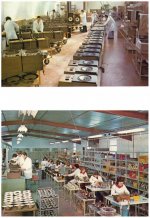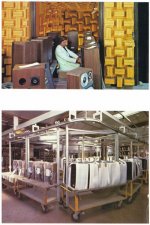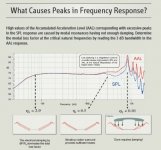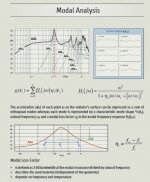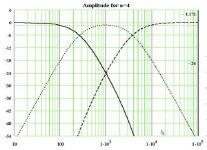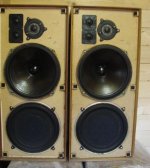As far as BSC goes, it depends: I have listened to several 'award winning' commercial designs, mostly 2- or multi way tower loudspeakers where ultimate bass extension (from 1 or more small mid-low drivers of scanspeak, seas etc.) apparently was a major design objective.
I know more than a few people who became quickly annoyed by the dominance of low frequencies, once the speakers were in their room. Many of these tower speakers have (full) BSC in their XO and some even port tuning that provokes a hump at the lowest freqs. (Indeed: creator of the 'one note bass').
Most people (I have met) prefer a clean bass (-3dB down to 45-50Hz or even higher) to the in room response of small drivers pushed down to 35Hz.
I know more than a few people who became quickly annoyed by the dominance of low frequencies, once the speakers were in their room. Many of these tower speakers have (full) BSC in their XO and some even port tuning that provokes a hump at the lowest freqs. (Indeed: creator of the 'one note bass').
Most people (I have met) prefer a clean bass (-3dB down to 45-50Hz or even higher) to the in room response of small drivers pushed down to 35Hz.
Last edited:
.... flat impedance and reduction of phase (time alignment) anomalies seem important ingredients to achieve 'musicality'. At least from my experience, these may in the end turn out to be of greater importance than striving for a flat frequency response (which could suck life out of drivers).
As far as BSC goes, it depends: I have listened to several 'award winning' commercial designs, mostly 2- or multi way tower loudspeakers where ultimate bass extension (from 1 or more small mid-low drivers of scanspeak, seas etc.) apparently was a major design objective.
I know more than a few people who became quickly annoyed by the dominance of low frequencies, once the speakers were in their room. Many of these tower speakers have (full) BSC in their XO and some even port tuning that provokes a hump at the lowest freqs. (Indeed: creator of the 'one note bass').
Most people (I have met) prefer a clean bass (-3dB down to 45-50Hz or even higher) to the in room response of small drivers pushed down to 35Hz.
I don't think that flat frequency response is able to suck life out of the loudspeakers if done properly. If one makes his goal just to make a ruler flat fr, then it might be the case. Anyhow, fighting with baffle step should be done very carefully. In smaller rooms where you can't position loudspeakers the right way, higher F3 usually works good - better than lower.
Other thing is, there are few ways to achieve BSC in a loudspeaker. The usual thing to do is to add pretty large series inductor and by that you incorporate BSC into the xover. I tried that and often came to the conclusion that it muddied up the mids somehow. When ever i can, i use series notch filter to flatten the baffle step hump - although that has its limitations, but it sounds better to me in a two way speaker.
Depending on room size, full BSC may be desired or not. With properly designed ported speakers in a room where you can do something like Cardas speaker placement, full BSC may be preffered, if not required.
Last edited:
Multiple subs to deal with room modes... Few people would find that an acceptable solution, aspecially in Europe where houses tend to be smaller.
I consider myself a bass addict, but not at any price.
Larger cones (high sensitivity) down to 40-50Hz overall produce more natural/musical results. Evidentally, this requires largers cabs, but could also (to a certain degree) eliminate the need for subs. In general: with larger cones, BSC becomes less of an issue and easier to deal with.
I consider myself a bass addict, but not at any price.
Larger cones (high sensitivity) down to 40-50Hz overall produce more natural/musical results. Evidentally, this requires largers cabs, but could also (to a certain degree) eliminate the need for subs. In general: with larger cones, BSC becomes less of an issue and easier to deal with.
Multiple subs to deal with room modes... Few people would find that an acceptable solution, aspecially in Europe where houses tend to be smaller.
I consider myself a bass addict, but not at any price.
Larger cones (high sensitivity) down to 40-50Hz overall produce more natural/musical results. Evidentally, this requires largers cabs, but could also (to a certain degree) eliminate the need for subs. In general: with larger cones, BSC becomes less of an issue and easier to deal with.
Agreed.
My Beyma 15K200 is tuned to achieve F3=40Hz in a 20sq-m room. It works pretty good.
Last edited:
These older Beyma 15K200 appear to be excellent drivers (as most products from Beyma) and similar to older JBL 15's. Certainly candidates for a big boy 2 way system combined with a nice (big) horn or waveguide and XO around 1000 kHz.
It's my guess the 350Hz dip in the on axis freq. response (in the specsheet) is due to the free space measurement on IEC baffle and not an issue in real life conditions?
It's my guess the 350Hz dip in the on axis freq. response (in the specsheet) is due to the free space measurement on IEC baffle and not an issue in real life conditions?
In real life conditions it is flat as a runway up to 1600Hz, and then roll of begins.
I tried it in 2way at 950Hz, but i didn't like it as much as with midrange added - but with smaller waveguide. My guess is that it's moving system is to heavy for good and detailed midrange - when used in small european rooms. In larger rooms it can be cranked up and it comes to life, but at low levels waveguide is working flawlessly, but woofer not so much. My friend has Deltalite II 2515 which is much better in that regard. Old Beyma 15LW30 was low Mms, revised version is more like my 15K200 in that regard
I tried it in 2way at 950Hz, but i didn't like it as much as with midrange added - but with smaller waveguide. My guess is that it's moving system is to heavy for good and detailed midrange - when used in small european rooms. In larger rooms it can be cranked up and it comes to life, but at low levels waveguide is working flawlessly, but woofer not so much. My friend has Deltalite II 2515 which is much better in that regard. Old Beyma 15LW30 was low Mms, revised version is more like my 15K200 in that regard
An externally hosted image should be here but it was not working when we last tested it.
Last edited:
In my perception, low mms is prerequisite for the ultimate transparency (liquidity) in the midrange, but a trade-off with regards to low-end performance. The rule of thumb dictates: mms is inversely correlated to Fs.
There are a few 'semi' exceptions, like Troels' JA8008 (HMQ). Due to delicate customisation of suspension parts (spider, light cone, rubberised foam surround etc.) and motor (big magnet, optimised gap/travel) this driver seems to laugh at Newton, at least on paper.
I used the word 'delicate' for a reason. As member sreten has pointed out here: http://www.diyaudio.com/forums/multi-way/206662-jantzen-ja8008-alternatives.html , in comparison of the JA8008 with the SEAS CA22RNY, power handling of the latter will be much higher due to extra coating, extra coil length and far more cone excursion.
There is a reason Troels has put several warnings/statements on power handling of his 'baby' on his website.
My preference would be to step up in cone size to have the same characteristics, but also the power handling and deal with driver coupling/integration issues by means of a proper waveguide and careful selection of (matching) drivers.
There are a few 'semi' exceptions, like Troels' JA8008 (HMQ). Due to delicate customisation of suspension parts (spider, light cone, rubberised foam surround etc.) and motor (big magnet, optimised gap/travel) this driver seems to laugh at Newton, at least on paper.
I used the word 'delicate' for a reason. As member sreten has pointed out here: http://www.diyaudio.com/forums/multi-way/206662-jantzen-ja8008-alternatives.html , in comparison of the JA8008 with the SEAS CA22RNY, power handling of the latter will be much higher due to extra coating, extra coil length and far more cone excursion.
There is a reason Troels has put several warnings/statements on power handling of his 'baby' on his website.
My preference would be to step up in cone size to have the same characteristics, but also the power handling and deal with driver coupling/integration issues by means of a proper waveguide and careful selection of (matching) drivers.
Last edited:
OSWG was made by my friend from Novi Sad. He made few versions, with lipover and without - so it can be mounted in cabinet or on the cabinet. Both worked like a charm.
They are made of 5mm fiberglass, so they are rock solid. White gel coat is a nice touch. I was thinking graphite gray but these were a gift - and they worked quite good.
They are made of 5mm fiberglass, so they are rock solid. White gel coat is a nice touch. I was thinking graphite gray but these were a gift - and they worked quite good.
...White gel coat is a nice touch. I was thinking graphite gray...
I guess our esthetic preferences are similar.
My 192L bass cabs are 'traffic white' (RAL 9016), so I may put a white WG on top or go for gray (or grey-ish).
But....we're drifting slightly off-topic, so I'll throw in some classic monitor material.
I guess our esthetic preferences are similar.
My 192L bass cabs are 'traffic white' (RAL 9016), so I may put a white WG on top or go for gray (or grey-ish).
But....we're drifting slightly off-topic, so I'll throw in some classic monitor material.
Last edited:
I suppose you and your friend are also members of the local communities over there?
If I am correct, I have seen similar diy waveguides in some East European forums.
By any change, is he perhaps the same guy that made this brilliant peaces of art?:
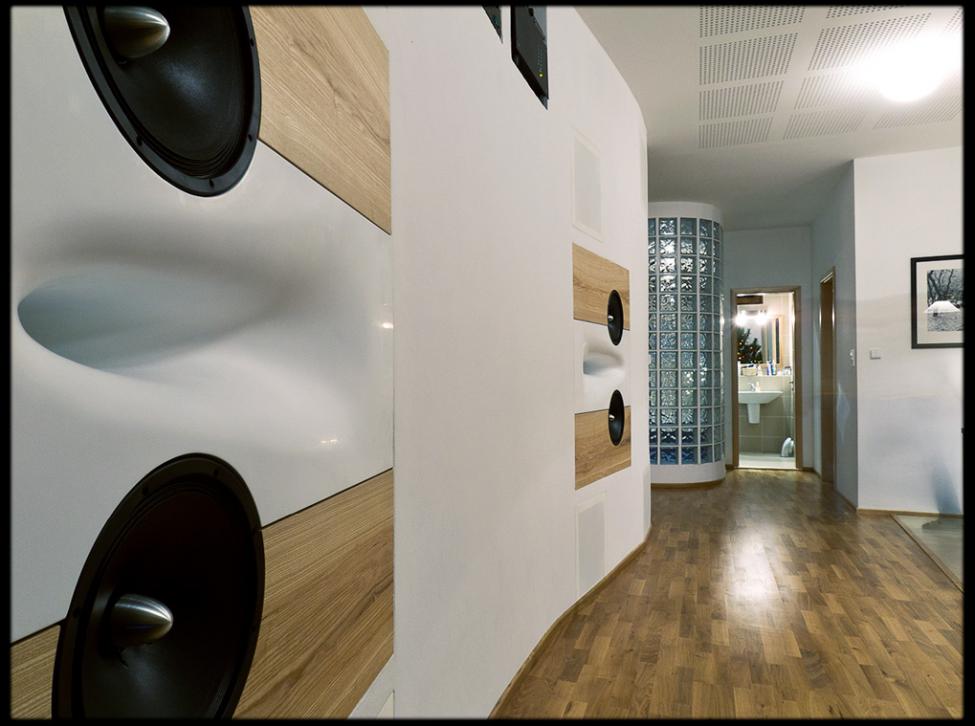
He might have. I didn't want to polish mine, and wg from your pics are polished. I can show him the pic and ask him if he is responsible for that work of art. Yes, we are both members of an East European forum. My friend is a museum curator and a sculptor but he is also great hi-fi enthusiast. This OSWG making was child's play for him since it is axisymmetric
Ze French

3A - Art & Acoustique Appliquée (later Reference 3A)
3A was originally set up in France in 1959 by French designer Daniel Dehay. 3A stands for Applied Acoustic Arts. 3A relocated to Switzerland in the late eighties under the name Reference 3A. The company passed into other hands before being repurchased by Mr. Dehay around 1992 and most of the features of all current models owe their heritage to his design precepts.
The salient features of Dehay's designs include direct connection of the main driver to the amplifier, time alignment of drivers and minimum phase change (by applying 1st order (6dB) crossovers) . His later designs have a distinctive sloping front baffle that a number of other companies have now adopted. Today the company is located in Kitchener, about 70 miles west of Toronto, Canada under the direction of Tash Goka of Divergent Technology.
An externally hosted image should be here but it was not working when we last tested it.

3A - Art & Acoustique Appliquée (later Reference 3A)
3A was originally set up in France in 1959 by French designer Daniel Dehay. 3A stands for Applied Acoustic Arts. 3A relocated to Switzerland in the late eighties under the name Reference 3A. The company passed into other hands before being repurchased by Mr. Dehay around 1992 and most of the features of all current models owe their heritage to his design precepts.
The salient features of Dehay's designs include direct connection of the main driver to the amplifier, time alignment of drivers and minimum phase change (by applying 1st order (6dB) crossovers) . His later designs have a distinctive sloping front baffle that a number of other companies have now adopted. Today the company is located in Kitchener, about 70 miles west of Toronto, Canada under the direction of Tash Goka of Divergent Technology.
3A started production in 1972 and had a large factory in Antibes on the French Riviera. They were often nicknamed as the "French JBL" and within a few years were established enough to make their own drivers.
They also claimed to have the largest anechoic chamber in Europe for testing their designs. That claim was certainly in tune with the owner's attitude!
These products were indeed often inspired by others, well enough manufactured to attract good reviews and were primarily sold in large retailers who were more interested in the fat margins than the most accurate sound...
Reference3a has never been a large manufacturer except for their (his; Daniel Dehay) reputation. It is still making very good speakers that are still using basically the same philosophy: controlled carbon woofer and minimal cross-over. Woofer without crossover with controlled natural rolloff, tweeter only 1st order meaning 1 single cap of the best quality (paper in oil). Dehay’s minimalist design principles are refreshingly simple: Connect the speaker’s midrange drivers directly to the amplifier, with no interfering electronic crossover. Align the drivers so that all parts of the sound waveform are correctly timed with each other. Design the drivers so that the sound remains in phase across frequencies, and build the domes and cones light and strong so that their output won’t break up within their designated frequency range. The result should be minimal distortion and maximal fidelity.

Regardless of where they were in 3A's line, the one thing that is common across all their various lines was that they built their own main drivers in house. They would out source the tweeters but Daniel Dehay always had the drivers built in house ensuring quality control. That's why the 3A's have a house sound. You'll also find that those main drivers will be a matched pair.
They also claimed to have the largest anechoic chamber in Europe for testing their designs. That claim was certainly in tune with the owner's attitude!
These products were indeed often inspired by others, well enough manufactured to attract good reviews and were primarily sold in large retailers who were more interested in the fat margins than the most accurate sound...
Reference3a has never been a large manufacturer except for their (his; Daniel Dehay) reputation. It is still making very good speakers that are still using basically the same philosophy: controlled carbon woofer and minimal cross-over. Woofer without crossover with controlled natural rolloff, tweeter only 1st order meaning 1 single cap of the best quality (paper in oil). Dehay’s minimalist design principles are refreshingly simple: Connect the speaker’s midrange drivers directly to the amplifier, with no interfering electronic crossover. Align the drivers so that all parts of the sound waveform are correctly timed with each other. Design the drivers so that the sound remains in phase across frequencies, and build the domes and cones light and strong so that their output won’t break up within their designated frequency range. The result should be minimal distortion and maximal fidelity.

Regardless of where they were in 3A's line, the one thing that is common across all their various lines was that they built their own main drivers in house. They would out source the tweeters but Daniel Dehay always had the drivers built in house ensuring quality control. That's why the 3A's have a house sound. You'll also find that those main drivers will be a matched pair.
Attachments
Last edited:
3a, or Mr. Dehay has designed a great many different loudspeaker models, not all of them are equally attractive, but I think his design philosphy is interesting and similar to the works of the late mr. Thiel. The growth rate in the early years of 3a is remarkable and testamony of the increasing demand for quality hifi during the 1970's.
I should note that parts of the above text were taken from 'french vintage hifi'.
Next up: some 3a highlights.
I should note that parts of the above text were taken from 'french vintage hifi'.
Next up: some 3a highlights.
Last edited:
You crack on, Ro808! Enjoying this 
I don't think you can go far wrong with a well-designed 8" bass like Jim Thiel used to use:
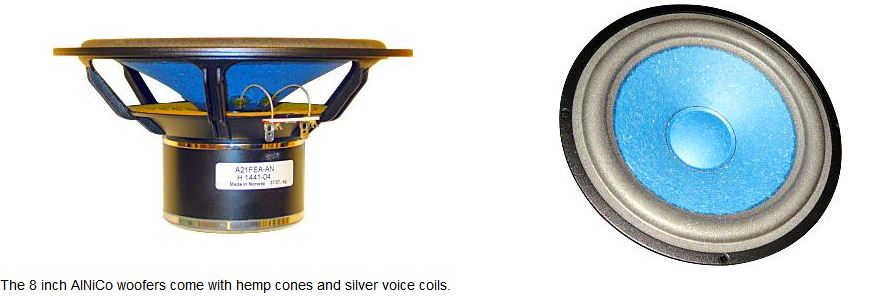
If you want to know about low mechanical loss with cardboard or plastic formers, because aluminium voicecoil formers have certain eddy-current losses IMO, there is little better source than Joachim Gerhard:
SpeakerBuilding.com - Interview with Joachim Gerhard of Audio Physic, Page 1.
IMO, there are always problems with splitting the range up in a two-way. The drivers are slightly outside their comfort zone. Dispersion has a hole. Above and below axis has a hole with even-order LR2 and LR4 crossovers. You can hear it.
I include some Klippel analysis of cone breakup, 1st and 2nd below. These are underdamped small metal cones, but show us what we are up against. The 1khz problem is actually the rubbery cone surround.
IMO, a three-way is always going to work better. The mid is spared bass excursion so distorts less, the tweeter is spared working below its comfort zone. Steen Duelund's mathematical analysis 3rd.
This is a good idea, IMO.
Next the Celestion Ditton 25, 4th, below. The twin low crossed Celestion HF1300 tweeters don't get driven into distortion due to the 6dB gain from twinning. A win, IMO.
In summary, all speakers are imperfect, but good engineering and some extra expenditure might help.
Completely off-topic, we might also learn a bit from the DarkSky site. Even with light, it's all about the signal (good) to noise (bad). So, IMO, French Citroen were doing good work with their comfortable Yellow non-dazzling headlights. Alas abandoned in favour of harsh and glaring EU bluer lighting which illuminates the real object of seeing not one bit. Because they destroy your night vision.
I don't think you can go far wrong with a well-designed 8" bass like Jim Thiel used to use:

If you want to know about low mechanical loss with cardboard or plastic formers, because aluminium voicecoil formers have certain eddy-current losses IMO, there is little better source than Joachim Gerhard:
SpeakerBuilding.com - Interview with Joachim Gerhard of Audio Physic, Page 1.
IMO, there are always problems with splitting the range up in a two-way. The drivers are slightly outside their comfort zone. Dispersion has a hole. Above and below axis has a hole with even-order LR2 and LR4 crossovers. You can hear it.
I include some Klippel analysis of cone breakup, 1st and 2nd below. These are underdamped small metal cones, but show us what we are up against. The 1khz problem is actually the rubbery cone surround.
IMO, a three-way is always going to work better. The mid is spared bass excursion so distorts less, the tweeter is spared working below its comfort zone. Steen Duelund's mathematical analysis 3rd.
This is a good idea, IMO.
Next the Celestion Ditton 25, 4th, below. The twin low crossed Celestion HF1300 tweeters don't get driven into distortion due to the 6dB gain from twinning. A win, IMO.
In summary, all speakers are imperfect, but good engineering and some extra expenditure might help.
Completely off-topic, we might also learn a bit from the DarkSky site. Even with light, it's all about the signal (good) to noise (bad). So, IMO, French Citroen were doing good work with their comfortable Yellow non-dazzling headlights. Alas abandoned in favour of harsh and glaring EU bluer lighting which illuminates the real object of seeing not one bit. Because they destroy your night vision.
Attachments
Last edited:
- Home
- Loudspeakers
- Multi-Way
- Classic monitor designs?

